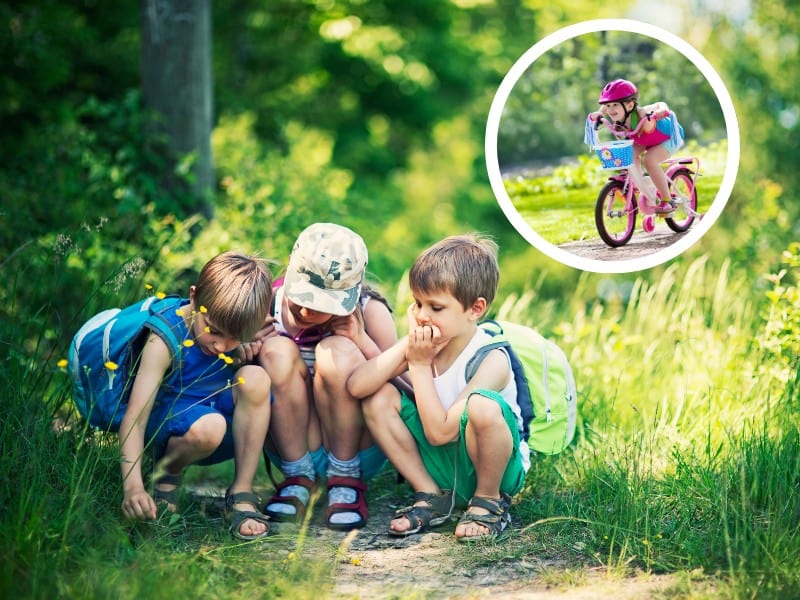Slow Summer: How to Say No to Over-Scheduling and Yes to a More Meaningful Season
Discover how to embrace a slow summer by saying no to over-scheduling and yes to meaningful moments. Learn why less structure can lead to more joy, connection, and rest for your family.

Play. Learn. Thrive.™ only endorses products we authentically love and use. Some of the product links in this post may be affiliate links. That means that if you click them and make a purchase, this site makes a commission. Play. Learn. Thrive.™ is also an Amazon Associate. As an Amazon Associate, we earn from qualifying purchases. It will have no impact on the price you pay or the experience of your purchase.
Every year, summer arrives with the promise of slower days, family adventures, and a break from the grind of the school year. Yet, for many families, the season quickly fills up with camps, structured activities, and social commitments, leaving little room for the unstructured, carefree days we envisioned.
The pressure to keep kids busy, entertained, and “productive” during summer is strong. Parents worry about the dreaded “I’m bored” complaints or feel guilted into signing up for every opportunity that comes their way. But what if the most meaningful summer isn’t one packed with activities but rather one that embraces simplicity, presence, and play?
Before we dive in, here’s a little about me so you know you’re getting advice from someone who’s been in the trenches! I’m Alanna Gallo, a former teacher with a master’s in education who saw firsthand how kids were losing confidence, independence, and their natural love of learning. I left the classroom to help parents raise curious, capable, and screen-conscious kids in a world that doesn’t make it easy. My work has been featured in major media outlets, and I’m here to give you real, research-backed advice—without the guilt trips or unrealistic expectations.

This year, let’s reclaim summer. Let’s slow down, say no to over-scheduling, and instead, create a season filled with connection, wonder, and rest.
Why We Over-Schedule in the First Place
Before we dive into how to slow down, let’s explore why so many parents find themselves trapped in an over-scheduled summer:
- Fear of Boredom – Many parents feel an underlying anxiety about their kids being bored, assuming they must constantly be engaged in activities.
- Social Pressure – Friends and family often ask, “What camps are your kids doing this year?” implying that a packed schedule is the norm.
- Work Constraints – Parents who work full-time often rely on structured activities to fill the summer hours, feeling like they have no other option.
- The Productivity Myth – We’ve been conditioned to equate productivity with success, even for kids. A “full” summer seems like a good summer.
- Parental Guilt – If we don’t enroll them in enrichment programs, will they fall behind? Are we doing enough for them?
But here’s the truth: Kids don’t need packed schedules to thrive. In fact, they need quite the opposite.
The Case for a Slow Summer
Slowing down doesn’t mean doing nothing—it means being intentional with how we spend our time. Here’s why a slow summer is not only beneficial but necessary for kids:
1. Boredom Fuels Creativity
When kids aren’t constantly entertained, they find ways to entertain themselves. Boredom is the birthplace of imagination, problem-solving, and self-directed learning. Free time encourages children to build forts, create stories, explore outside, and tap into their natural curiosity.

2. Unstructured Play is Essential
Research consistently shows that play—not structured activities—is the foundation of childhood development. Play strengthens social-emotional skills, encourages independence, and allows children to follow their interests at their own pace.
3. Deepens Family Connection
A slower summer means more time for connection. Instead of shuttling kids between activities, families can enjoy simple, meaningful moments together—reading books on a blanket in the backyard, taking evening walks, making homemade popsicles, or just talking without the rush of the next commitment.
4. Supports Emotional Well-Being
Overscheduling can lead to stress, exhaustion, and burnout—even for kids. Just like adults, children need downtime to reset, reflect, and enjoy the present moment. A slower pace allows for deeper emotional regulation and a calmer, more joyful home.
5. Encourages Independence & Self-Discovery
When kids aren’t constantly directed by schedules, they have the space to explore their interests and develop autonomy. They get to decide what to do, how to spend their time, and what excites them—key components of raising confident, self-motivated kids.
How to Say No to Over-Scheduling This Summer
If the idea of a slow summer resonates with you, but you’re unsure how to actually make it happen, here are practical ways to push back against the pressure to over-schedule:
1. Set a Clear Intention
Decide what you want summer to feel like for your family. Peaceful? Playful? Restorative? Then, make choices that align with that vision. Instead of filling your calendar reactively, be intentional about what makes it onto your summer schedule.
2. Limit Structured Commitments
Instead of signing up for multiple camps and extracurriculars, consider choosing just one or two that your child is genuinely excited about. Leave large blocks of time open for free play, exploration, and downtime.
3. Prioritize Unstructured Time
Create a rhythm for your days that includes long stretches of unscheduled time. Morning nature walks, lazy afternoons with books, or simple backyard play—these moments are where childhood magic happens.

4. Embrace Simple Pleasures
A slow summer isn’t about doing nothing; it’s about making room for the simple joys that often get pushed aside in a busy schedule. Here are a few ideas:
- Reading outside in the shade
- Drawing with sidewalk chalk
- Watching the clouds and making up stories
- Making s’mores in the backyard
- Playing in the sprinkler
- Stargazing on warm nights
5. Say “No” with Confidence
It’s okay to decline invitations or commitments that don’t align with your slow summer intention. A simple, “We’re keeping things really low-key this summer” is all you need to say.
6. Encourage Self-Directed Play
One of the best things about a slow summer is that kids learn to entertain themselves. Resist the urge to structure every moment, and instead, let them figure out how to fill their time.
7. Swap “What Are We Doing Today?” for “What Do You Feel Like Exploring?”
Instead of looking at summer as a schedule to fill, reframe it as an open invitation to explore, create, and connect in the moment.
Ready to Cut Back on Screen Time?

Our free Screen-Free Starter Kit gives you gentle, research-backed strategies to reduce screen time and reconnect with your child—without guilt, tears, or power struggles.
✨ Create a calmer, more connected home—starting today.
Creating a Slow Summer Bucket List
If you like having ideas at the ready without the pressure of a schedule, create a Slow Summer Bucket List—a collection of experiences that can be done at any time, without over-planning. Here are a few ideas:
- Have a picnic at the park
- Visit a local farmer’s market
- Camp out in the backyard
- Spend a day exploring tide pools or a lake
- Make homemade lemonade
- Learn a new craft together
- Go on a family bike ride
- Visit the library and stock up on books
- Make a nature journal
- Take an impromptu road trip to a nearby town
The key? No rigid timelines—just a list of possibilities.

Choosing a More Meaningful Summer
A slow summer is a choice. It’s a choice to resist the pressure to fill every moment and instead embrace the beauty of being—being present, being playful, and being together.
By saying no to over-scheduling, we’re saying yes to something even greater: a childhood filled with freedom, exploration, and meaningful connection.
This summer, let’s let go of the pressure, trust in the power of play, and create space for the moments that matter most. Because in the end, it’s not the number of camps attended or activities completed that make a summer memorable—it’s the slow, simple, and joyful moments that truly stick.
Inspired by this post? Be sure to subscribe download my free Screen-Free Starter Kit! For more insights and resources on raising confident, lifelong learners, be sure to follow me on Instagram – can't wait for you to join me!







